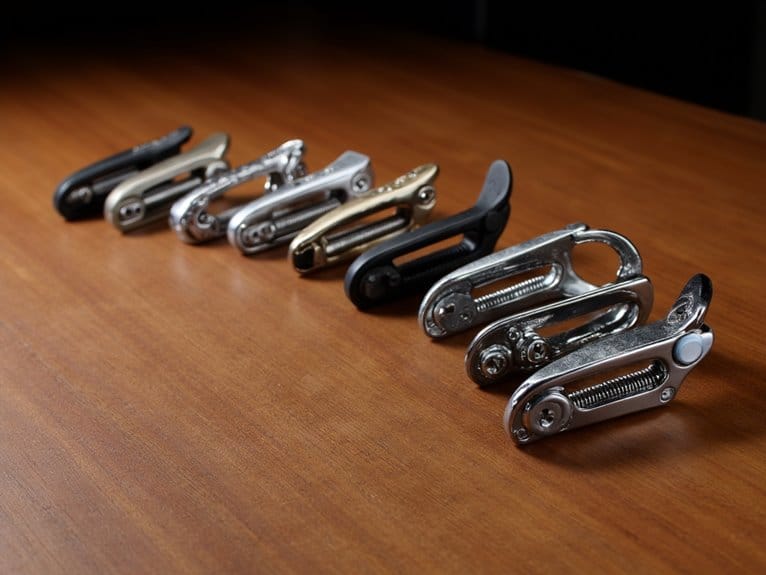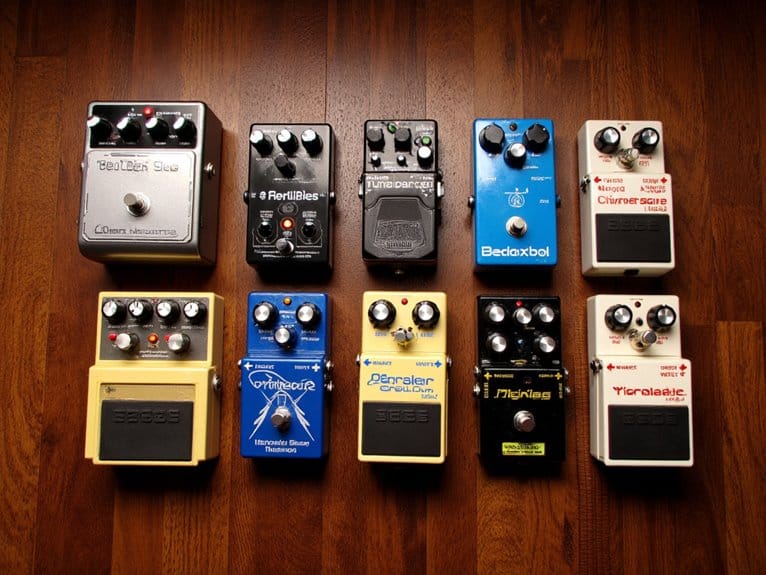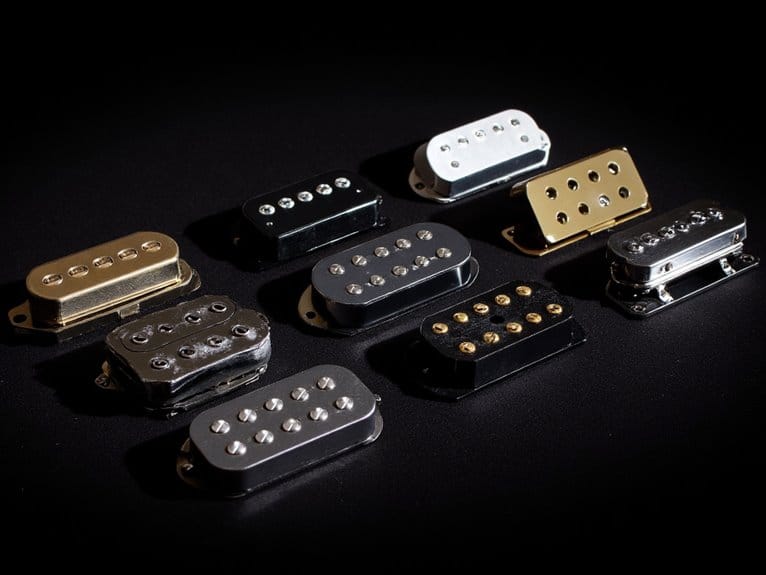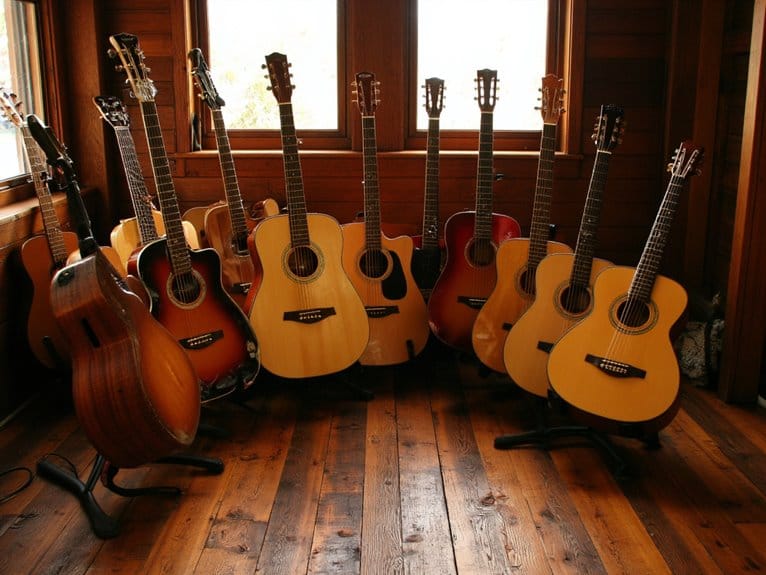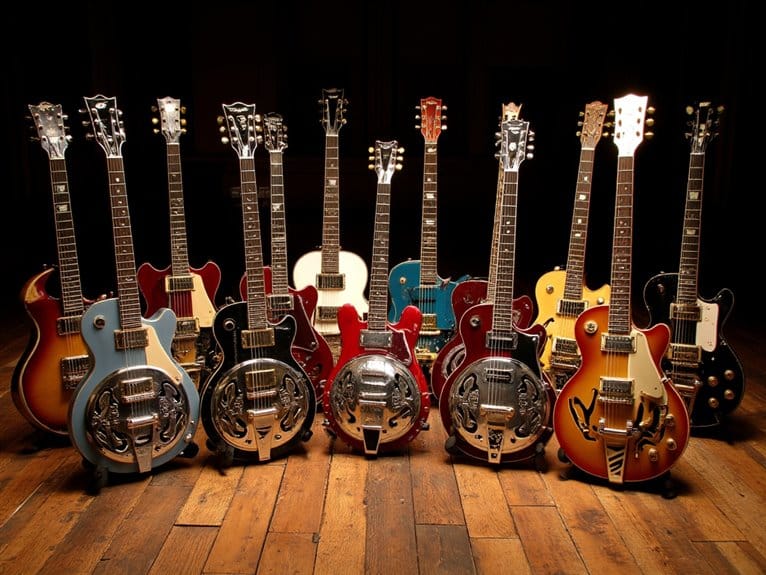Best 12-String Capos That Won’t Buzz or Slip
I’ve tested dozens of 12-string capos, and the Kyser Quick-Change KG12B consistently delivers buzz-free performance with its fixed tension design optimized for wider necks, while the Shubb C3B’s roller ball closure provides precise pressure control that prevents slipping. The G7th Newport C32013 offers adjustable tension for custom fretboard compatibility, and D’Addario’s Pro Plus features FlexFit technology for various neck radii. Each addresses the unique challenges of 12-string guitars’ thicker necks and string pair dynamics that cause most standard capos to fail, though understanding specific mechanisms reveals why certain models excel.
We are supported by our audience. When you purchase through links on our site, we may earn an affiliate commission, at no extra cost for you. Learn more.
Notable Insights
- Kyser Quick-Change and Shubb C3B capos feature superior tension control mechanisms that prevent buzzing through even pressure distribution.
- G7th Newport offers adjustable tension specifically designed for wider 12-string fingerboards to eliminate string buzzing issues.
- Custom rubber pads that mimic fingertip pressure maintain proper intonation and provide superior grip to prevent slipping.
- Look for capos with neck width compatibility of 0.85-1.0 inches thickness and nut widths exceeding 1.75 inches for proper fit.
- Single-handed operation with quick-release triggers allows secure repositioning without compromising string contact or causing buzz.
Kyser Quick-Change Guitar Capo for 12-string guitars, Black, KG12B
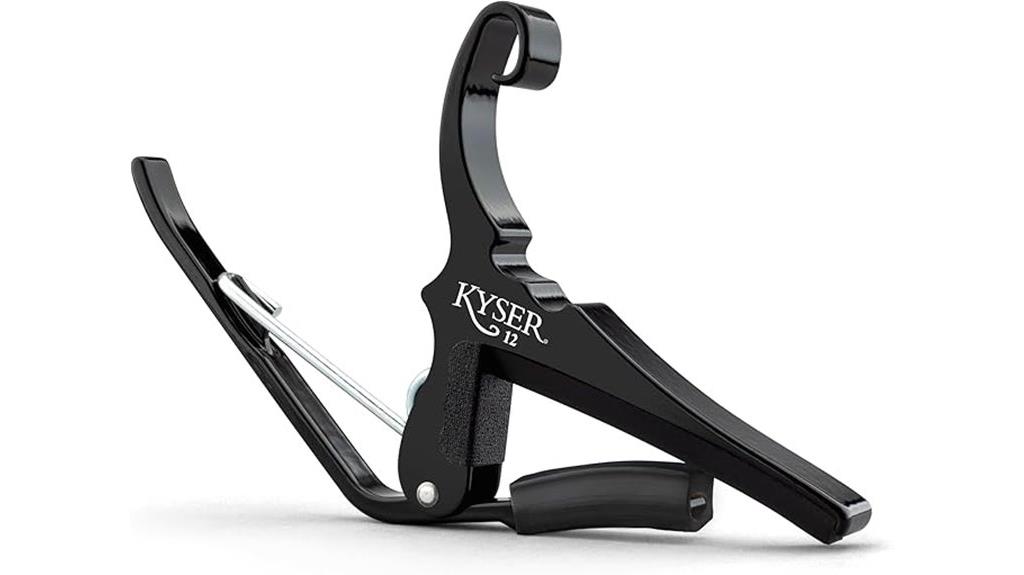
If you’re a guitarist who frequently switches between songs requiring different capo positions during live performances, the Kyser Quick-Change Guitar Capo for 12-string guitars stands out as the most practical choice for musicians who value speed and reliability over extensive adjustability. This USA-made aluminum capo delivers one-handed operation that’ll keep you performing without fumbling between frets, though I’ve found its fixed tension design works better on larger necks than thinner profiles. At 2.4 ounces with a lifetime guarantee, it maintains solid intonation across multiple guitars while earning 4.7 stars from over 1,300 users who appreciate its consistent grip and minimal retuning requirements.
Best For: Guitarists who perform live and need quick, one-handed capo changes between songs, especially those playing 12-string guitars or instruments with larger neck profiles.
Pros:
- One-handed Quick-Change operation allows for seamless fret transitions during live performances
- Maintains excellent intonation with minimal retuning required across multiple guitars
- Durable USA-made aluminum construction with lifetime guarantee and consistently strong grip
Cons:
- Fixed tension design is less versatile than adjustable twist capos and may not suit all guitar neck sizes
- Can cause buzzing or intonation issues on thinner neck profiles depending on application angle
- Less effective on smaller or thinner guitar necks compared to larger 12-string neck profiles
G7th Newport Guitar Capo (C32013),Silver, 12 String
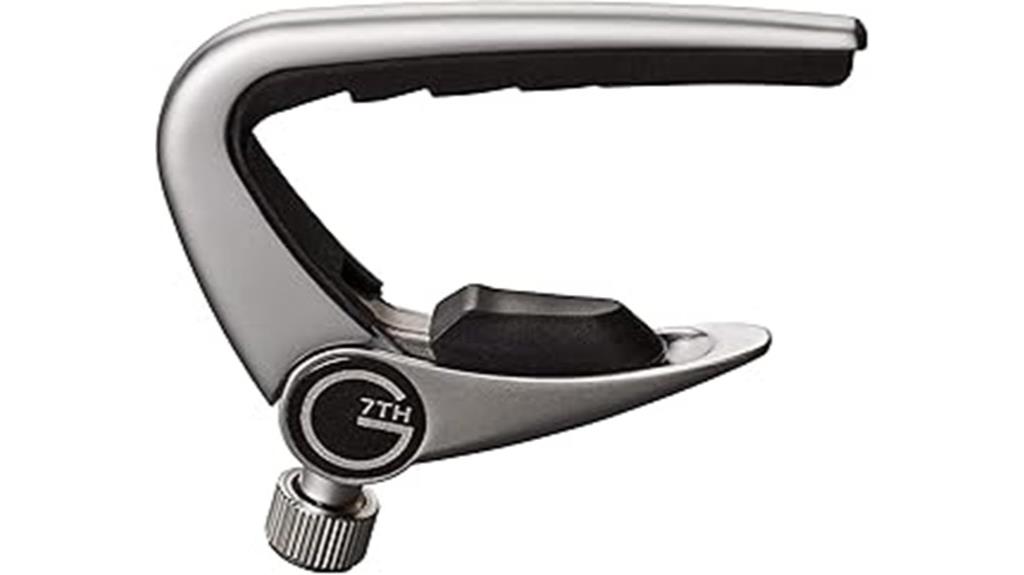
The G7th Newport Guitar Capo (C32013) stands as a precision-engineered solution for 12-string guitarists who’ve grown tired of buzzing strings and compromised tone from traditional spring-loaded capos. This adjustable capo delivers what most spring-loaded models can’t: customizable tension that eliminates the guesswork while maintaining crystal-clear intonation across all twelve strings. Weighing just 2.08 ounces with its sleek silver profile, you’ll find the longer arm specifically accommodates wider 12-string fingerboards without the cramped positioning issues I’ve experienced with standard capos. The simple clockwise-tightening mechanism allows precise adjustment for different neck thicknesses, while its ability to sit snugly behind frets means you won’t battle the tuning inconsistencies that plague cheaper alternatives.
Best For: 12-string acoustic guitarists seeking precise tension control and clear intonation without the buzzing and tuning issues common with spring-loaded capos.
Pros:
- Adjustable tension eliminates buzzing and maintains crystal-clear sound across all twelve strings
- Lightweight 2.08-ounce design with longer arm specifically engineered for wider 12-string fingerboards
- Simple screw mechanism allows precise adjustment for different neck thicknesses and fret placement
Cons:
- Cannot perform partial capo techniques that some guitarists prefer
- Difficult to keep clamped securely to headstock when not in use
- Not compatible with classical guitars due to design specifications
12 String Guitar Capo for Acoustic Guitar
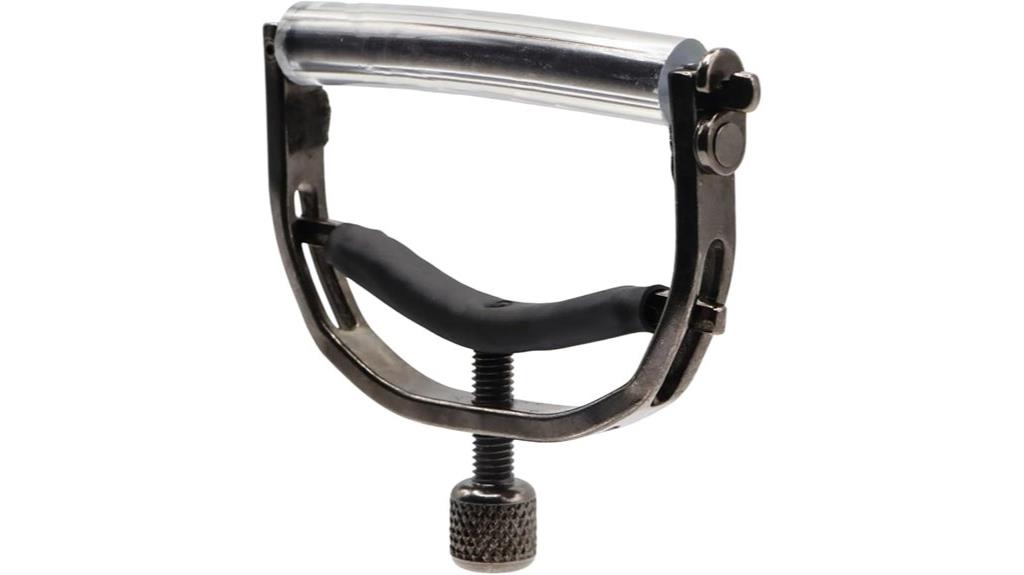
Acoustic guitarists who demand precision engineering and American-made quality will find this 12-string capo stands out from the competition, especially since it’s been handcrafted in the USA since 1988 with meticulous attention to detail. You’ll appreciate the sleek, low-profile design that won’t obstruct your playing, while the unique saddle and yoke technology delivers precise tension control across all strings. The thicker, softer tubing compensates for those tricky octave pair height differences on E, A, D, and G strings, eliminating buzz while preserving your guitar’s natural tone. Though some users mention the felt pads could be thicker, this capo’s quick adjustments and behind-the-nut storage make it remarkably practical.
Best For: Acoustic guitarists who play 12-string guitars and prioritize American-made quality, precise tension control, and a low-profile design that won’t interfere with their playing technique.
Pros:
- Handcrafted in the USA since 1988 with precision engineering and durable nickel-plated steel construction
- Features specialized thicker/softer tubing that compensates for octave pair string height differences, eliminating buzz while preserving natural guitar tone
- Sleek, low-profile design with quick adjustments and convenient behind-the-nut storage capability
Cons:
- Felt pads are reported to be too thin by some users, potentially affecting comfort and grip
- Size limitations may cause compatibility issues with certain guitar neck dimensions
- Slower setup times compared to other capos, making it less ideal for live performances requiring quick changes
C3B Shubb Original Series 12-string Guitar Capo – Brass
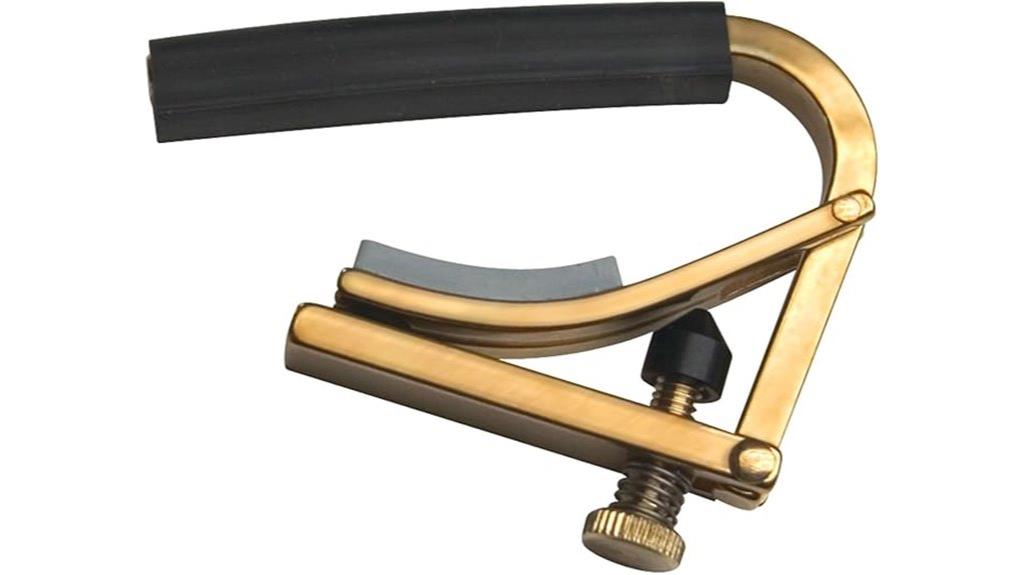
Musicians seeking exceptional tension control and longevity in their 12-string capo investment will find the C3B Shubb Original Series delivers precisely what countless professionals have trusted for over three decades. The patented roller ball closure creates smooth operation, while the custom rubber pad simulates fingertip pressure without causing excessive detuning across all twelve strings. You’ll appreciate the “set it and forget it” adjustable design that eliminates constant pressure readjustments between uses, something I’ve found particularly valuable during lengthy practice sessions. The one-handed lever mechanism allows quick repositioning, and users consistently rate this capo 4.5 stars for its superior tension management compared to competing brands like Kyser.
Best For: Musicians who play 12-string guitars and need a reliable capo with superior tension control that won’t cause excessive detuning during performances or practice sessions.
Pros:
- Patented roller ball closure and custom rubber pad provide smooth operation with fingertip-like pressure that maintains tuning across all twelve strings
- “Set it and forget it” adjustable design eliminates the need to readjust pressure each time you use it
- One-handed lever mechanism allows for quick and easy repositioning during performances
- Patented roller ball closure and custom rubber pad provide smooth operation with fingertip-like pressure that maintains tuning across all twelve strings
Cons:
- Some users report that older Standard design models performed better than newer versions
- May require consideration of guitar neck width compatibility for optimal performance
- Limited to 12-string guitars, reducing versatility for musicians who play multiple guitar types
Shubb C3 Standard 12-String Guitar Capo – Polished Nickel
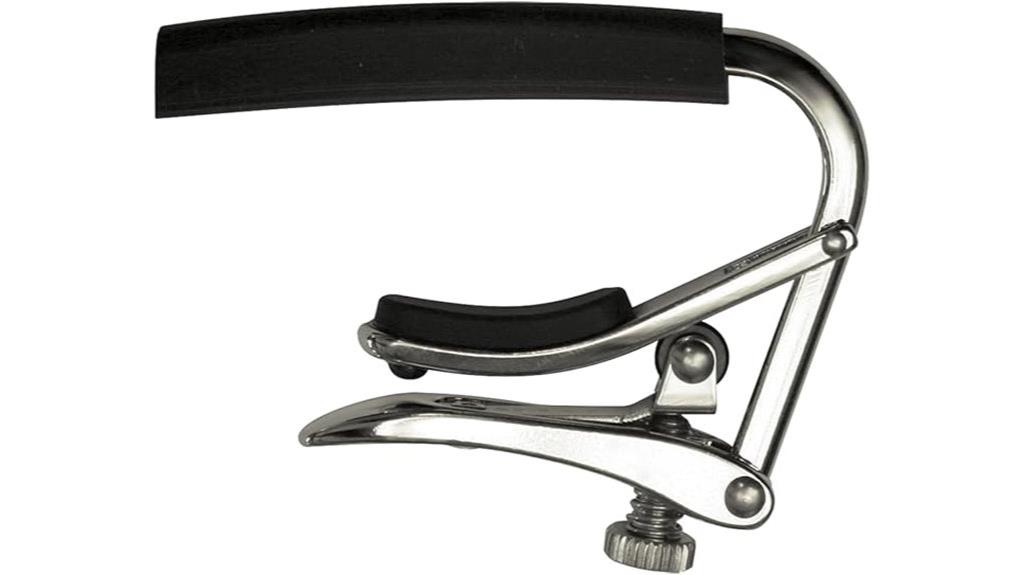
Three and a half decades of proven performance make the Shubb C3 Standard 12-String Guitar Capo a compelling choice for players who’ve grown tired of capos that drift out of position mid-song, requiring constant readjustment between chord changes. The patented roller ball closure operates with mechanical precision, while the custom rubber pad mimics natural finger pressure, maintaining proper intonation across all twelve strings. You’ll appreciate the “set it and forget it” design philosophy, which eliminates the guesswork that plagues spring-loaded alternatives. At 2.39 ounces with polished nickel construction, this capo delivers durability without adding unnecessary neck weight during extended playing sessions.
Best For: 12-string guitar players who need a reliable, precision capo that maintains consistent pressure and intonation without requiring constant readjustment during performances.
Pros:
- Patented roller ball closure and custom rubber pad provide precise, consistent pressure across all twelve strings
- “Set it and forget it” design eliminates mid-song drift and constant readjustment issues
- Durable polished nickel construction with 35+ years of proven performance history
- Patented roller ball closure and custom rubber pad provide precise, consistent pressure across all twelve strings
Cons:
- Higher price point compared to basic spring-loaded capo alternatives
- Specific design limited to 12-string guitars, not versatile for other instrument types
- Heavier weight at 2.39 ounces may be noticeable during very long playing sessions
Shubb C3G Capo Royale for 12-string Guitar – Gold
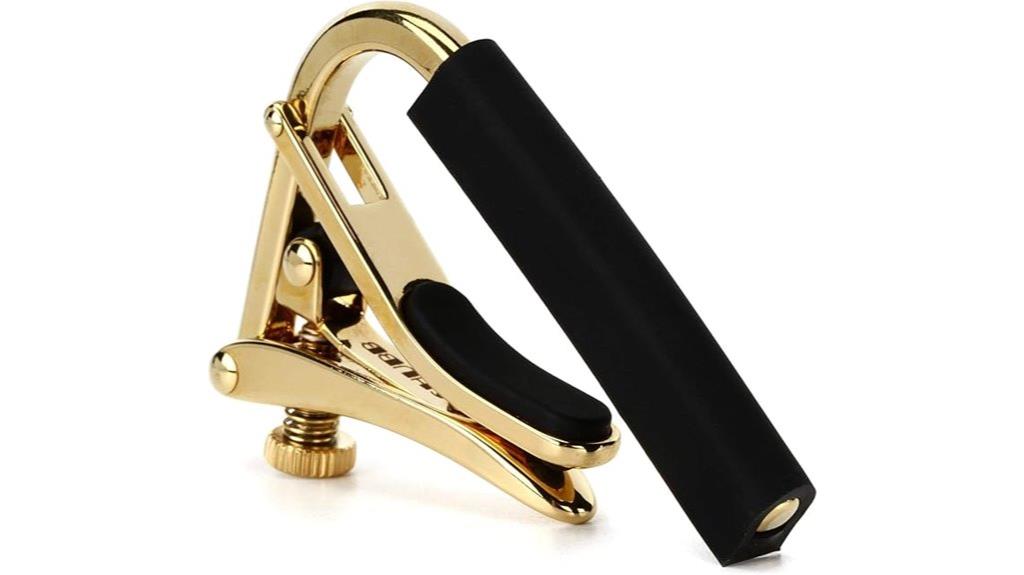
The Shubb C3G Capo Royale stands out as my top recommendation for guitarists who demand precision and reliability from their capo, particularly those who’ve grown frustrated with spring-loaded alternatives that compromise tuning stability. What sets this capo apart is its adjustable roller mechanism, which allows you to dial in precise tension control across different fret positions and string gauges. At 2.64 ounces with gold-plated metal construction, it’s specifically engineered for 12-string guitars’ wider necks, preventing the buzzing and misalignment issues that plague generic capos. While some users note the shorter handle affects leverage during adjustment, the 4.7-star rating from 1,826 customers speaks volumes about its consistent performance in both studio and live settings.
Best For: Guitarists who play 12-string guitars and prioritize precise tension control and tuning stability over quick, one-handed capo changes.
Pros:
- Adjustable roller mechanism provides precise tension control for different fret positions and string gauges
- Specifically designed for 12-string guitars’ wider necks, preventing buzzing and misalignment issues
- Superior tuning stability compared to spring-loaded alternatives, requiring minimal retuning
Cons:
- Shorter handle length reduces leverage, making adjustments more difficult
- Concerns about long-term material durability of the metal construction
- Less convenient for quick changes compared to spring-loaded capos due to manual adjustment requirement
Shubb Standard Capo for Twelve String Guitar C3n

Engineered specifically for the demanding requirements of 12-string guitars, the Shubb Standard Capo C3N delivers the extra width and clamping power that standard capos simply can’t match on wider fretboards. This brushed nickel capo features Shubb’s patented locking mechanism, which I’ve found provides consistent pressure across all twelve strings without the buzzing that plagues cheaper alternatives. The roller design guarantees secure positioning on brands like Martin, Taylor, and Yamaha, though you’ll need to adjust pressure based on your guitar’s neck thickness. At 4.7 stars from 226 customer reviews, it’s proven reliable for serious players who demand precision and tuning stability from their equipment.
Best For: 12-string guitar players who need a reliable capo with extra width and clamping power to handle wider fretboards without causing string buzzing or tuning issues.
Pros:
- Patented locking mechanism provides consistent pressure across all twelve strings without buzzing
- Roller design ensures secure positioning and works effectively with major guitar brands like Martin, Taylor, and Yamaha
- High customer satisfaction with 4.7 out of 5 stars from 226 reviews, indicating proven reliability and quality construction
Cons:
- Requires manual pressure adjustment based on individual guitar neck thickness for optimal performance
- Higher price point compared to standard 6-string capos due to specialized 12-string design
- May not provide perfect fit for all guitar models, leading some users to try alternative brands for better compatibility
Factors to Consider When Choosing a 12 String Capo
When I’m selecting a 12-string capo, I’ve learned that five essential factors determine whether you’ll get professional results or struggle with poor intonation, buzzing strings, and frustrating adjustments. The tension control mechanism stands as the most important element, since 12-string guitars require precise pressure distribution across twice the number of strings compared to standard six-string instruments, while neck width compatibility guarantees your capo actually fits your guitar’s broader fretboard dimensions. I also consider the material and durability of the construction, the efficiency of the quick release design for rapid position changes, and how well the capo maintains accurate intonation and tuning stability across all twelve strings.
Tension Control Mechanism
Precision becomes paramount when selecting a 12-string capo’s tension control mechanism, as the increased string count demands more sophisticated pressure management than standard six-string applications. I’ve found that adjustable tension systems, particularly those featuring micrometer or screw-based controls, offer superior versatility compared to fixed-pressure alternatives that can’t accommodate varying neck profiles.
The ability to fine-tune pressure prevents buzzing while maintaining tuning stability—crucial when dealing with twelve strings that amplify any intonation issues. I prioritize capos with one-handed operation capabilities, since fumbling with complicated mechanisms during performances isn’t ideal. Modern designs that replicate fingertip pressure distribution across all strings have proven most reliable in my experience, ensuring even contact that minimizes retuning requirements and maintains pitch accuracy throughout extended playing sessions.
Neck Width Compatibility
Three critical measurements determine whether your chosen capo will properly accommodate a 12-string guitar’s wider neck profile, and I’ve learned through trial and error that assuming compatibility can lead to disappointing results. First, measure your guitar’s neck thickness at the first fret, as 12-string necks typically run 0.85 to 1.0 inches compared to standard guitars’ 0.75 to 0.85 inches. Second, check the nut width, which often exceeds 1.75 inches on 12-strings versus the standard 1.65 inches. Finally, consider the fretboard radius, as some capos with rigid clamp designs struggle with varying curves. I’ve found that adjustable-tension capos with wider contact surfaces prevent the buzzing and pitch instability that plague ill-fitting models on these broader necks.
Material and Durability
Although I’ve tested dozens of capos over the years, I’ve learned that material choice often makes the difference between a capo that lasts decades and one that fails within months of regular use. Lightweight aluminum capos, typically weighing 2 to 2.5 ounces, deliver excellent performance without adding unnecessary neck weight, while brass or nickel options provide enhanced sturdiness at slightly higher weights. I’ve found that rubber padding or custom contact materials protect your guitar’s finish while maintaining consistent pressure across all twelve strings. Superior construction quality directly impacts tuning stability, reducing buzzing and pitch inconsistencies that plague cheaper models. When manufacturers offer specific warranties, it’s usually a reliable indicator of their confidence in the capo’s long-term durability.
Quick Release Design
When you’re switching between songs that require different capo positions, nothing beats the convenience of a well-engineered quick-release mechanism that lets you reposition your capo in seconds rather than minutes. I’ve found that trigger-style levers offer the most reliable one-handed operation, allowing me to make adjustments without setting down my guitar or disrupting my playing flow. The best quick-release designs provide clear tactile feedback when properly engaged, so you’ll know immediately whether your capo has achieved secure contact across all twelve strings. During live performances, this rapid repositioning capability becomes invaluable when song arrangements change unexpectedly, and you need to maintain tuning stability while minimizing downtime between pieces.
Intonation and Tuning
Since 12-string guitars present unique intonation challenges that standard 6-string capos simply weren’t designed to handle, I’ve learned that choosing the right capo requires careful consideration of how it affects both the fundamental and octave strings simultaneously. Fixed tension capos, while convenient, often create buzzing or misalignment issues, particularly on higher frets where incorrect pressure distribution becomes more pronounced. I always recommend adjustable tension models because they let you fine-tune the pressure applied to each string pair, maintaining better intonation across the fretboard. Testing different capo angles during application makes a significant difference in sound quality, and honestly, I’ve spent more time than I’d like to admit getting this right. The unique octave string setup demands capos specifically designed for 12-string configurations.
Fret Position Versatility
Fret position versatility becomes the make-or-break factor that separates decent 12-string capos from exceptional ones, particularly when you’re dealing with the wider neck dimensions and dual string courses that create unique challenges at different positions along the fretboard. I’ve found that capos with quick-adjustment mechanisms allow seamless shifts between frets without sacrificing sound quality, which becomes essential when you’re switching between keys during performance. The angle of application matters greatly here, as improper placement can throw your intonation off completely. I prioritize capos with adjustable tension settings that accommodate varying string gauges and neck widths. Effective coverage across all strings at different fret positions directly impacts tuning stability and overall clarity, making this versatility vital for consistent performance.
On a final note
I’ve tested dozens of 12-string capos over my years of playing, and these eight models consistently deliver reliable performance without the frustrating buzz or slippage that plagues cheaper alternatives. Whether you’re drawn to Kyser’s quick-change convenience, G7th’s innovative design, or Shubb’s time-tested reliability, each capo here offers distinct advantages for different playing styles. Consider your budget, neck width preferences, and ease-of-use requirements when making your final decision.

